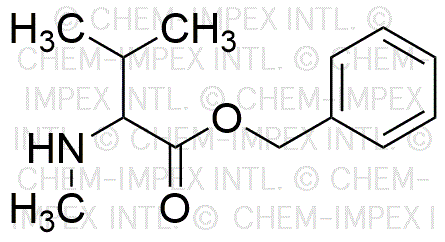N-Methyl-(S)-valine benzyl ester is widely utilized in research focused on:
- Pharmaceutical Development: This compound serves as a key intermediate in the synthesis of various pharmaceuticals, particularly in the development of peptide-based drugs.
- Biochemical Research: It is used in studies related to amino acid metabolism and protein synthesis, helping researchers understand cellular processes better.
- Chiral Synthesis: The compound's chiral nature makes it valuable in asymmetric synthesis, providing a means to create enantiomerically pure compounds that are crucial in drug formulation.
- Biotechnology: In the biotechnology sector, it is employed in the production of modified proteins, enhancing their stability and activity for therapeutic applications.
- Analytical Chemistry: It is also utilized as a standard in analytical methods, aiding in the quantification and characterization of amino acids in various samples.
General Information
Properties
Safety and Regulations
Applications
N-Methyl-(S)-valine benzyl ester is widely utilized in research focused on:
- Pharmaceutical Development: This compound serves as a key intermediate in the synthesis of various pharmaceuticals, particularly in the development of peptide-based drugs.
- Biochemical Research: It is used in studies related to amino acid metabolism and protein synthesis, helping researchers understand cellular processes better.
- Chiral Synthesis: The compound's chiral nature makes it valuable in asymmetric synthesis, providing a means to create enantiomerically pure compounds that are crucial in drug formulation.
- Biotechnology: In the biotechnology sector, it is employed in the production of modified proteins, enhancing their stability and activity for therapeutic applications.
- Analytical Chemistry: It is also utilized as a standard in analytical methods, aiding in the quantification and characterization of amino acids in various samples.
Documents
Safety Data Sheets (SDS)
The SDS provides comprehensive safety information on handling, storage, and disposal of the product.
Product Specification (PS)
The PS provides a comprehensive breakdown of the product’s properties, including chemical composition, physical state, purity, and storage requirements. It also details acceptable quality ranges and the product's intended applications.
Certificates of Analysis (COA)
Search for Certificates of Analysis (COA) by entering the products Lot Number. Lot and Batch Numbers can be found on a product’s label following the words ‘Lot’ or ‘Batch’.
*Catalog Number
*Lot Number
Certificates Of Origin (COO)
This COO confirms the country where the product was manufactured, and also details the materials and components used in it and whether it is derived from natural, synthetic, or other specific sources. This certificate may be required for customs, trade, and regulatory compliance.
*Catalog Number
*Lot Number
Safety Data Sheets (SDS)
The SDS provides comprehensive safety information on handling, storage, and disposal of the product.
DownloadProduct Specification (PS)
The PS provides a comprehensive breakdown of the product’s properties, including chemical composition, physical state, purity, and storage requirements. It also details acceptable quality ranges and the product's intended applications.
DownloadCertificates of Analysis (COA)
Search for Certificates of Analysis (COA) by entering the products Lot Number. Lot and Batch Numbers can be found on a product’s label following the words ‘Lot’ or ‘Batch’.
*Catalog Number
*Lot Number
Certificates Of Origin (COO)
This COO confirms the country where the product was manufactured, and also details the materials and components used in it and whether it is derived from natural, synthetic, or other specific sources. This certificate may be required for customs, trade, and regulatory compliance.


